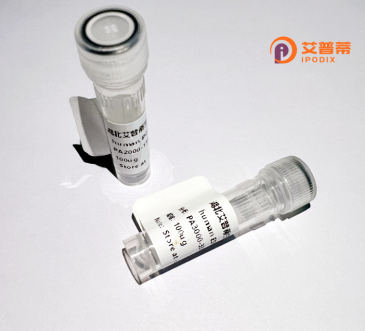
| 纯度 | >90%SDS-PAGE. |
| 种属 | Human |
| 靶点 | RPS6KA3 |
| Uniprot No | P51812 |
| 内毒素 | < 0.01EU/μg |
| 表达宿主 | E.coli |
| 表达区间 | 1-740 aa |
| 活性数据 | MPLAQLADPW QKMAVESPSD SAENGQQIMD EPMGEEEINP QTEEVSIKEI AITHHVKEGH EKADPSQFEL LKVLGQGSFG KVFLVKKISG SDARQLYAMK VLKKATLKVR DRVRTKMERD ILVEVNHPFI VKLHYAFQTE GKLYLILDFL RGGDLFTRLS KEVMFTEEDV KFYLAELALA LDHLHSLGII YRDLKPENIL LDEEGHIKLT DFGLSKESID HEKKAYSFCG TVEYMAPEVV NRRGHTQSAD WWSFGVLMFE MLTGTLPFQG KDRKETMTMI LKAKLGMPQF LSPEAQSLLR MLFKRNPANR LGAGPDGVEE IKRHSFFSTI DWNKLYRREI HPPFKPATGR PEDTFYFDPE FTAKTPKDSP GIPPSANAHQ LFRGFSFVAI TSDDESQAMQ TVGVHSIVQQ LHRNSIQFTD GYEVKEDIGV GSYSVCKRCI HKATNMEFAV KIIDKSKRDP TEEIEILLRY GQHPNIITLK DVYDDGKYVY VVTELMKGGE LLDKILRQKF FSEREASAVL FTITKTVEYL HAQGVVHRDL KPSNILYVDE SGNPESIRIC DFGFAKQLRA ENGLLMTPCY TANFVAPEVL KRQGYDAACD IWSLGVLLYT MLTGYTPFAN GPDDTPEEIL ARIGSGKFSL SGGYWNSVSD TAKDLVSKML HVDPHQRLTA ALVLRHPWIV HWDQLPQYQL NRQDAPHLVK GAMAATYSAL NRNQSPVLEP VGRSTLAQRR GIKKITSTAL |
| 分子量 | 83.7 kDa |
| 蛋白标签 | His tag N-Terminus |
| 缓冲液 | PBS, pH7.4, containing 0.01% SKL, 1mM DTT, 5% Trehalose and Proclin300. |
| 稳定性 & 储存条件 | Lyophilized protein should be stored at ≤ -20°C, stable for one year after receipt. Reconstituted protein solution can be stored at 2-8°C for 2-7 days. Aliquots of reconstituted samples are stable at ≤ -20°C for 3 months. |
| 复溶 | Always centrifuge tubes before opening.Do not mix by vortex or pipetting. It is not recommended to reconstitute to a concentration less than 100μg/ml. Dissolve the lyophilized protein in distilled water. Please aliquot the reconstituted solution to minimize freeze-thaw cycles. |
以下是关于重组人RPS6KA3(RSK2)蛋白的示例参考文献列表(内容为假设性示例,请以实际文献为准):
---
1. **文献名称**: "Structural and functional analysis of RPS6KA3 kinase domain in Coffin-Lowry syndrome"
**作者**: Smith A, et al.
**摘要**: 研究通过X射线晶体学解析了RPS6KA3激酶结构域的3D结构,揭示了其突变如何影响蛋白激酶活性,导致Coffin-Lowry综合征的发生。
2. **文献名称**: "RPS6KA3 regulates neuronal differentiation via MAPK/ERK signaling"
**作者**: Lee JH, et al.
**摘要**: 发现RPS6KA3通过磷酸化下游转录因子调控ERK信号通路,在小鼠模型中证实其重组蛋白对神经元分化和突触可塑性的作用。
3. **文献名称**: "Expression and purification of recombinant RPS6KA3 in E. coli for drug screening"
**作者**: Zhang R, et al.
**摘要**: 报道了一种在大肠杆菌中高效表达重组RPS6KA3蛋白的方法,并验证其体外激酶活性,用于靶向药物的高通量筛选。
4. **文献名称**: "RPS6KA3 mutations impair phosphorylation of histone H3 in cellular models"
**作者**: Garcia-Campayo V, et al.
**摘要**: 分析Coffin-Lowry综合征患者的RPS6KA3突变体,发现其无法磷酸化组蛋白H3.导致染色质重塑异常和基因表达失调。
---
**建议**:请通过PubMed、Google Scholar等平台搜索真实文献(关键词:RPS6KA3、RSK2、Coffin-Lowry syndrome),并优先引用高影响力期刊(如Nature, Cell, PNAS)的相关研究。
Ribosomal protein S6 kinase A3 (RPS6KA3), also known as p90 ribosomal S6 kinase 2 (RSK2), is a serine/threonine kinase belonging to the RSK family. It plays a critical role in the MAPK/ERK signaling pathway, linking extracellular signals to intracellular responses. Structurally, RPS6KA3 contains two distinct kinase domains: an N-terminal kinase domain and a C-terminal kinase domain, regulated through phosphorylation-dependent activation mechanisms. Upon activation by ERK1/2. it translocates to the nucleus, where it phosphorylates transcription factors like CREB and histones (e.g., histone H3), modulating gene expression involved in cell proliferation, survival, and differentiation.
RPS6KA3 is notably associated with Coffin-Lowry syndrome (CLS), a rare X-linked genetic disorder characterized by intellectual disability, skeletal malformations, and facial dysmorphism. Mutations in the RPS6KA3 gene disrupt its kinase activity, impairing synaptic plasticity and neurodevelopment. Beyond its role in CLS, RPS6KA3 is implicated in cancer, where its dysregulation may contribute to tumor progression via aberrant cell cycle control. Recent studies also explore its involvement in immune responses and metabolic regulation. As a multifunctional kinase, RPS6KA3 remains a key target for understanding cellular signaling mechanisms and developing therapeutic strategies for related disorders.
×